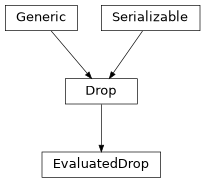Drop¶

Drops are the main data structure in HermesPy that represent the results of a full simulation scenario run. It contains all signal models at different states of the signal processing as well as the information generated by the final digtial processing layers.
- class Drop(timestamp, device_transmissions, device_receptions)[source]¶
Bases:
Generic[DTT,DRT],SerializableDrop containing the information transmitted and received by all devices within a scenario.
- Parameters:
- classmethod Deserialize(process)[source]¶
Deserialize an object’s state.
Objects cannot be deserialized directly, instead a
Factorymust be instructed to carry out the deserialization process.- Parameters:
process (
DeserializationProcess) – The current stage of the deserialization process. This object is generated by theFactoryand provides an interface to deserialization methods supporting multiple backends.- Return type:
- Returns:
The deserialized object.
- serialize(process)[source]¶
Serialize this object’s state.
Objects cannot be serialized directly, instead a
Factorymust be instructed to carry out the serialization process.- Parameters:
process (
SerializationProcess) – The current stage of the serialization process. This object is generated by theFactoryand provides an interface to serialization methods supporting multiple backends.- Return type:
- class EvaluatedDrop(timestamp, device_transmissions, device_receptions, artifacts)[source]¶
Bases:
DropDrop containing the information transmitted and received by all devices within a scenario as well as their evaluations.
- Parameters:
timestamp (float) – Time at which the drop was generated.
device_transmissions (Sequence[DeviceTransmission]) – Transmitted device information.
device_receptions (Sequence[DeviceReception]) – Received device information.
artifacts (Sequence[Artifact]) – Evaluation artifacts generated for this scenario drop.